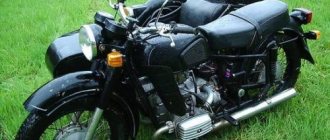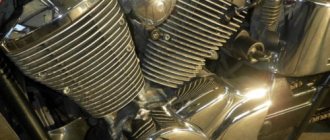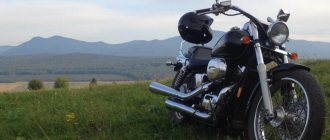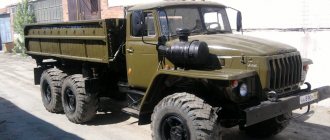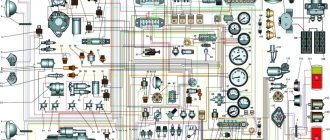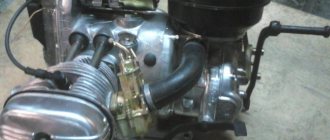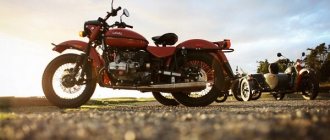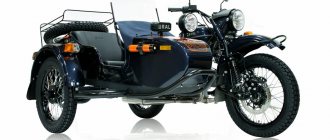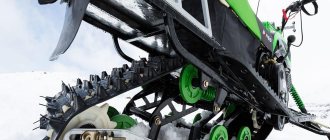Specifications
The technical characteristics of the Ural-4320 truck allowed it to remain in production for more than 40 years. The properties of the equipment depend on the type of installed engine and attachments.
Some parameters of the all-terrain vehicle:
- maximum speed - 72-85 km/h;
- turning radius (for three-axis version) - 11.4 m;
- braking distance (at a speed of 40 km/h) - no more than 15.0 m;
- ford depth - 1.5 m;
- climbability - 28-58%;
- permissible descent (while holding the parking brakes) is 25-30%.
Transmission
The transmission of three-axle vehicles includes a dry clutch and a manual gearbox. Further distribution of power flows is carried out by the transfer gearbox and cardan shafts. There is a separate shaft between the transfer case and the gearbox. The middle bridge has a pass-through design, which made it possible to reduce the number of elements in the power transmission. The cardan shafts are equipped with serviceable joints with needle bearings.
The car's axles are a cast crankcase into which axle shaft stockings are pressed. At the ends of the front axle there are steering knuckles with constant velocity joints. Two-stage axle gearboxes include a bevel pair and spur gears. The gear ratio is the same for all axles. The plant supplied several variants of gearboxes, differing in the number of teeth on the gears. The crankcase has a symmetrical differential mechanism. The axle shafts have splines at the ends that serve to connect to the wheel hub.
The Ural-43206 version has technical characteristics and chassis design that are slightly different from three-axle vehicles. Due to the absence of a middle axle, the transmission design has been simplified, in which there are only 3 driveshafts.
Engine
The early series of the truck were equipped with a naturally-aspirated 8-cylinder diesel engine KamAZ-740. The unit has 2 blocks located at an angle of 90°, working volume 10850 cm³. The engine is equipped with individual heads for each cylinder, and a mechanical pump is used to supply fuel. Engine power 210 hp. at 2600 rpm, peak torque was 65 kgf/m at 1500-1800 rpm. Fuel consumption on the Ural-4320 is 26-28 liters per 100 km.
After a fire at a motor plant in Naberezhnye Chelny in 1993, a shortage of motors arose. The trucks began to use 6- and 8-cylinder YaMZ engines models 236 and 238. The power of the units was 180 and 240 hp. respectively. The engine capacity is 11150 and 14866 cm³. To install the 238 diesel engine, the engine compartment and hood had to be lengthened, and this configuration of the front of the cabin subsequently became standard.
In addition, in those same years, small batches of cars equipped with a powerful gasoline engine ZIL-375 were produced. Engine power 180 hp with a working volume of 6962 cm³. The fuel consumption rate (AI 93 gasoline) is 48 liters per 100 km.
Subsequently, the modernized 230-horsepower YaMZ-236NE2 was installed on the trucks. The power plant was equipped with a turbocharger without an additional compressed air cooler. There are cars with an in-line 6-cylinder 275-horsepower YaMZ-53623-10.
Steering
The controls and steering mechanism of the Ural are located on the left. The column has a fixed position. The design has a power steering (hydraulic booster) with a two-way operating mode. The steering is equipped with a mechanical gearbox with a built-in spool distributor of working fluid flows. To operate the amplifier, there is a vane pump mounted on the engine cylinder block.
Chassis and suspension
The truck chassis is a riveted frame, the side members are stamped from low-alloy steel. To increase the rigidity and installation of units, there are cross members. The front axle is mounted on two semi-elliptical leaf springs. Elastic elements work together with hydraulic double-sided shock absorbers. A similar suspension scheme provides improved off-road properties of the Ural chassis.
The rear suspension depends on the type of car. On the 6x6 version, there are reinforcements on the rear of the frame, to which the rear axle balance trolley is attached. The structure includes 2 springs and 6 reaction rods that serve to transmit pushing loads. The 4x4 version has a dependent suspension on leaf springs with springs. Additionally, hydraulic shock absorbers are installed.
Dimensions and filling capacities
The truck is equipped with 1 or 2 fuel tanks. The volume of the fuel tank mounted on the side of the spar is 210 liters. On some models, an additional 60 liter tank was used, located inside the frame. The volume of the tank in the Urals is not completely filled with fuel. This is due to the thermal expansion of the liquid and design features. The filling capacity of the tanks is 204 or 57.6 liters of fuel.
The overall dimensions of the vehicle depend on the number of installed axles. Thus, the length of the machine of the three-axle model is 7375 mm, and the two-axle version is 7725 mm. The width of the Ural of all models is 2500 mm (excluding mirror sizes). The weight of the truck in running order is 8000-8700 kg, the total weight of the on-board version reaches 15205 kg.
Filling volumes of vehicle components:
- cooling system - 30 l;
- engine crankcase - 21.5 l;
- power steering - 4.5 l;
- gearbox housing - 8.5 l;
- transfer gearbox - 3.5 l;
- axles - 4.5 l.
Dismantling and assembling the gearbox of a Ural motorcycle
To disassemble the gearbox, proceed as follows:
- dismantle the clutch mechanism along with the bearing;
- remove the starter lever, then the rubber coupling located on the secondary shaft;
- remove the gear shift housing cover;
- Unscrew the lid of the box and carefully remove it from the shafts.
Complete disassembly of the clutch mechanism, gear selection mechanism and kickstarter is allowed only when repairing them - otherwise there is no need to disassemble them.
The Ural motorcycle gearbox is assembled with reverse gear in reverse order. After assembly, the gear shift mechanism must be adjusted, otherwise problems may arise when choosing them.
The gearbox of a Ural motorcycle with reverse speed begins to be adjusted by placing the motorcycle on the stand. Then the 2nd speed is turned on and the pedal is pressed to the 3rd gear. If the ball coincides with the well, adjustment of the lower adjustment screw is not required. After moving from 3rd speed, you need to return to the second and check the alignment of the ball, tighten the upper screw if it does not match. This completes the gear selection adjustment.
The Ural motorcycle allows you to repair the gearbox with minimal effort, thanks to the simplicity of its design, which distinguishes this model from other two-wheeled vehicles.
Device
Ural vehicles use an all-metal cabin designed for 3 people. The power unit, closed by the hood, is located in front of the driver. This arrangement provides good protection for the vehicle’s crew in the event of a mine explosion, but impairs visibility for the driver. The Ural clutch device includes a pneumohydraulic booster, which reduces the level of physical activity. Behind the cabin there is a platform or other equipment.
Electrical equipment
The electrical circuit of the Ural-4320 is single-wire, with an operating voltage of 24V. The negative terminal of the battery is connected to the body and body parts. Wiring harnesses are routed in the truck cab and under the bed.
The electrical circuit of cars is protected by cylindrical fuses designed for a current of 8-16A. To protect against short circuits, a bimetallic insert is installed, triggered at a current of 30A. The node is reusable. The electrical wiring is colored insulated, which simplifies repair and maintenance.
Brake system
The Ural brake system has a mixed drive. When you press the brake pedal, the pneumatic booster is activated, which transmits pressure to the hydraulic lines. The working fluid enters the actuator cylinders and presses the pads to the surface of the brake drums. The hydraulic drive is divided into 2 circuits: the first serves the front and middle axles, and the second serves only the rear axle. If any circuit breaks down, the remaining one provides full braking of the car.
At the output of the transfer gear shaft of the all-terrain vehicle there is a separate drum mechanism, which is a parking brake. Switching on is carried out using a lever located in the driver's cabin. A pneumatically controlled auxiliary brake, called a mountain brake, is installed in the engine exhaust pipe. When a control signal is applied, the gas exhaust channel is blocked and the fuel supply is simultaneously turned off.
Cooling system
The engines of the all-terrain vehicle have a closed forced-type cooling system; the coolant is a special liquid Tosol-A. Short-term filling of lines with distilled water is allowed. In winter, the water must be drained while it is parked, since when it freezes there is a risk of the jacket rupturing.
The heat exchanger is a tubular-plate radiator; the air flow through the honeycomb is created using a fan. There are 2 thermostats in the system lines that maintain the engine temperature within the required limits. Fluid circulation is carried out by a mechanical pump driven by a belt from the crankshaft.
To make it easier to start the engine in winter, a pre-heater PZD 30 is used, running on diesel fuel. The design of the device has an electric pump that ensures fluid circulation and uniform heating.
Air system
The power unit contains a two-cylinder compressor, which is a source of compressed air. The all-terrain vehicle is equipped with several receivers for storing a supply of compressed gas. The cabin has a dial pressure gauge for the pneumatic system. The trucks are equipped with a centralized tire inflation system, which improves the off-road parameters of the Ural vehicle. Windshield wipers and a PSU installed in the clutch drive are connected to the pneumatic lines.
Transmission
Transmission models for the Urals depend on the version of the installed engine. Early cars used a KamAZ 141 five-speed manual transmission. The clutch was a dry type, equipped with 2 working discs. When using engines from the Yaroslavl plant, a five-speed YaMZ 236 gearbox and a single-plate clutch are installed. The control drive uses a hydraulic drive and a pneumatic amplifier. In the cabin there is an information plate with a Ural gear shift diagram.
On the gearbox housing there is a standard place for installing a power take-off gearbox. There are several models that allow operation only when parked or while the all-terrain vehicle is moving.
The transmission has a two-speed transfer gearbox that proportionally distributes power flows between the front axle and the rear bogie. The transfer case includes a center differential equipped with a pneumatically driven lock. Both gears of the Ural transfer case are low, the gear ratios depend on the model of the power unit. A description of the gearbox control circuit is available on a plate attached to the instrument panel.
Ural motorcycle gearbox with reverse speed
How to independently remove, disassemble and assemble the gearbox of a Ural motorcycle.
Over its long life, the gearbox of the Ural motorcycle has undergone several modifications, including the addition of a reverse gear. The use of a secondary shaft in the gearbox made it possible to increase productivity and significantly reduce the size of the box, which is very important for a motorcycle. Repairing and assembling the gearbox of a Ural motorcycle is not very difficult, and this work can be done independently.
Modifications
Based on the basic all-terrain vehicles, the Ural Automobile Plant produced a number of modifications intended for military or civilian use. Some versions are manufactured by third parties that receive the chassis from the chassis manufacturer. Vehicles are shipped equipped with both standard suspension and reinforced front axle springs. Such cars are designated as Ural-43203.
Onboard
The flatbed version is the most common. There are trucks that differ in platform size and side height. There is a car model built on the long wheelbase chassis 4320-19. Lengthening the platform made it possible to place cargo weighing up to 12 tons.
The characteristics of the Ural-4320 with an onboard platform are enhanced by installing hydraulic manipulators. The extendable lift arm is located behind the cab and is equipped with an individual hydraulic system with a spool valve. An onboard vehicle with a CMU is capable of independently loading and unloading cargo weighing up to 6050 kg, and can also be used as a small-sized crane.
Dump truck
Dump trucks based on the Ural are equipped with a hydraulic drive to unload the platform. The hydraulic system is powered by a gear pump located on the power take-off. An example of such equipment is UST-5453, designed for transporting ore and coal. The machine has a load capacity of 8200 kg, the total weight reaches 20470 kg.
Tank truck
Various tanks designed for transporting water or petroleum products are installed on the Ural chassis. An example of a fuel tanker is the ATZ-10, equipped with a steel tank holding 10,000 liters of liquid. A pumping unit is used to pump fuel.
Fire trucks are assembled on the basis of the all-terrain vehicle by third-party companies. The Ural-43202-ATs-40 tank truck is equipped with a double cabin designed to accommodate 6 crew members. There is a tank at the rear that can hold 4000 liters of water. There is an additional 200-liter foam concentrate tank. A centrifugal pump located at the rear of the machine is used to supply the extinguishing agent. The unit weighs 14,850 kg and has a speed of up to 80 km/h.
Army models
The Russian army truck Ural-4320 is used for transporting personnel and towing various types of weapons. There are special military versions equipped with cabins made of armor plates and bulletproof glass. A special protected module is installed inside the on-board platform, designed to transport 15-20 people. At the same time, the standard canvas awning is retained.
The armored car Ural-4320-09-31 has this design. The internal elements of the vehicle's cabin, including the floor panels and rear wall, are made from armor plate. The armored roof has an access hatch that can be used to mount a machine gun. There are 2 individual seats inside the cabin. A special mask is installed to protect the radiator; the side parts of the hood provide protection for the power unit.
Pipe hauling tractor
To build the equipment, the Ural-43204 chassis is used, which has an increased load capacity. The truck tractor is equipped with a model 904702 dismantling, which allows transporting pipes 12 m long. When working along the route, the equipment moves pipes up to 36 m long, with a pipe diameter of 530-1420 mm.
Other models
The owners independently install superstructures based on the Ural chassis, which provide a comfortable living space. Such cars received the nickname “Leshy”.
Various vans adapted for the installation of technological equipment are mounted on the Ural-43203-10 chassis. There are drilling rigs, truck cranes and other equipment.
Reference data
Design changes to the Ural car:
18. Reference data
Information about the stages of modernization of axle gearboxes for 6x6 vehicles.
- 1984 - introduction of an additional bevel gear bearing (an angle was introduced to lubricate the bevel gear bearing and the gearbox configuration was changed).
- 1996 - two additional holes were introduced on the gearbox flange for mounting to the bridge Ø 19 mm and the diameters of 7 (seven) holes were increased from Ø 15 mm to Ø 17 mm.
- 1999 - the material of the adjusting nut 375-2403040 was changed instead of KCh and is made of 35L steel.
- 2001 - a locking plate for fixing the differential nut 375-2403042 was introduced, increasing the size of the locking part from 46 mm to 51 mm.
- Since 2003 A gearbox with a fixed side cover and a square is offered as spare parts (for example, a gearbox with i = 7.32:
- 4320-2302007 — front axle gearbox
4320-2402007/2502007 — rear/middle axle gearbox)
The gearbox is supplied unpainted and preserved for spare parts. The serial production number and production date are stamped on the gearbox housing flange. A plate with the gear ratio and car model stamped on it should be installed under the cup cover bolt 375-2402135.
Operation and repair manual
Each vehicle comes with an instruction manual. Before starting operation, you must familiarize yourself with the manufacturer’s recommendations, which will allow you to avoid breakdowns and costly repairs.
- After starting a cold power unit, do not allow operation at high speeds. Movement is allowed to begin only after warming up to +40°C.
- If the engine was running at high speeds under load, then it should idle for 2-3 minutes before stopping. Such manipulation is necessary for uniform cooling of structural elements.
- It is forbidden to completely drain the fuel from the tanks, as this leads to air entering the fuel supply system.
- When driving on hard ground, it is not recommended to engage the center differential. When blocked, accelerated wear of transmission elements and tires begins.
- It is prohibited to drive on a rut with the steering wheel turned all the way.
- Movement should begin only after reaching a pressure of 4 kgf/cm² in the pneumatic system. At a reduced value, the vehicle's braking system does not provide effective deceleration.
When operating equipment, there are several types of maintenance:
- Daily, which is carried out when the car leaves the route and immediately after returning.
- Seasonal, produced in spring and autumn.
- The next one, which comes in categories TO-1 or TO-2 (after 4000 and 16000 km, respectively). It is also possible to carry out work according to the engine hour meters - after 125 or 500 hours of engine operation.
The required list of actions is given in the service instructions. The manufacturers and types of technical fluids that must be used when replacing are also indicated there. It is not recommended to use materials that differ in characteristics from the manufacturer's recommendations.
How to change gears without a clutch
If you have a manual transmission car (manual gearbox) and you are moving in third gear, then in order to switch to the higher “fourth” gear, you must first engage neutral. To do this, you need to release the gas and move the gear shift lever to the neutral position. Then shift the lever to the desired gear position. After the engine speed of the gearbox gears coincides, torque transmission will occur. In the same way, you can shift to higher gears without almost squeezing the clutch in all brands of cars that are “equipped” with mechanics.
We recommend reading: Circumstances of the accident
For beginners who are just learning to drive, the main problem is the manual gearbox. Problems with shifting arise especially in understanding, and at first by touch, which gear is quite difficult. This confusion, in turn, can cause serious transmission breakdowns, or worse, create an emergency situation.
How to change gears on a car correctly
- Release the gas pedal.
- Reduce the speed of the car to the speed of the desired gear.
- Depress the clutch all the way.
- Move the lever to the desired position without delay in neutral.
- Smoothly release the clutch and simultaneously press the gas pedal.
- untimely switching off the gear and pressing the clutch;
- long transition from low to high gear;
- sharply pressing the gas after switching to a higher gear;
- asynchronous operation of the clutch and gas.
KamAZ gear shift diagram: features and recommendations
Starting off is carried out in a low gear. Shifting is carried out only when the clutch is disengaged. The KamAZ gearshift diagram on the ZF gearbox involves switching in several stages. This is expressed in the features of upshifts and downshifts. Thus, the car can move quickly on various types of road surfaces. The optimal pattern is considered to be 1B-2B-3B at the first stage, 4H-4B-5H during the subsequent movement. Based on this diagram, you need to start from the first low gear, i.e. you do not need to change the position of the lever on the gearbox until the 4th gear. In order for the car to start, it is necessary to increase the crankshaft speed to 7 thousand revolutions. The second gear is engaged when the rotation speed reaches 3000 rpm (number 3 on the tachometer).
It should be noted that the operation of the crankshaft in KamAZ vehicles plays a key role. If you change gears in time, you can significantly reduce fuel consumption and ensure economical engine operation without significant downtime.
When to shift gears on a manual transmission: gear shift order and features
Passenger cars are usually equipped with a 4-speed, 5-speed or 6-speed gearbox. On trucks, the number of gearbox gears reaches 12 (due to the use of half stages for more efficient use of internal combustion engine torque under high traction loads).
At the same time, it is the manual transmission that allows you to fully understand the concept of “driving a car.” In order to learn how to drive a manual transmission and professionally drive a car with such a gearbox, you need to understand the circuit diagram of its structure and know the operating principle of its mechanisms.
How to correctly change the gearbox on a KAMAZ
The design of the ten-speed transmission is a five-speed gearbox, complemented by a divider gearbox. Thanks to the device, the vehicle can use 10 forward gears, as well as two reverse ones. When the production of KamAZ trucks began, it was expected that these vehicles would operate under conditions of high load capacity. The engineers of the automobile concern created a new transmission model, which was called 152.
- A spool valve, which is used to control a gearbox. It is installed on the shift lever support. Operates in forward and reduced speed modes.
- Pressure reducing valve. Used to select compressed air flow from a pneumatic unit. This valve bleeds air when the pressure in the system is too high. From this device, air flows to the control valve, as well as the valve for switching on the dividing device. This leads to the appearance of two circuits simultaneously in the internal combustion engine control system.
- Divider activation valve. Provides compressed air flow to the device when the driver disengages the clutch. This makes it possible to activate and deactivate the reduced speed in parallel with the gear changes on the main gearbox.
- Dividing mechanism. Includes a piston installed inside a cylinder. The piston rod is connected to a lever mounted on the fork shaft of the assembly. When compressed air enters the device, it causes the piston to move in a certain direction. Its displacement helps to change the operating mode.
- Air distribution pipe of the dividing mechanism. Used to supply air flow to the cylinder of the unit.
